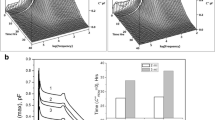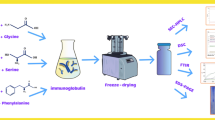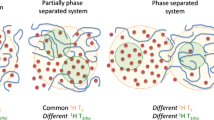Abstract
Purpose. To examine whether the empirical Kohlrausch-Williams-Watts (KWW) equation is applicable not only to protein aggregation but also to protein denaturation in lyophilized formulations. Lyophilized β-galactosidase (β-GA) formulations containing polyvinylalcohol and methylcellulose were used as model formulations. The possibility of predicting storage stability based on the temperature dependence of the estimated parameters of inactivation/aggregation—time constant (τ) and its distribution (β) is discussed.
Methods. Protein aggregation in lyophilized β-GA formulations at 10-70°C and 6-43% relative humidity was determined as a function of time by size exclusion chromatography. Enzyme activity was also determined using 2-nitrophenyl-β-D-galactopyranoside as a substrate.
Results. Inactivation and aggregation of β-GA were describable with the empirical KWW equation, regardless of whether the temperature was above or below the NMR relaxation-based critical mobility temperature (Tmc) or whether protein molecules with different degrees of deformation resulting from stresses during lyophilization exist in the formulation. The estimated β parameter for protein aggregation decreased rapidly as temperature increased beyond Tmc because the mobility of polymer molecules increased in the initial stages of glass transition. The time required for 10% enzyme to aggregate (t90) calculated from the τ and β parameters exhibited a change in temperature dependence gradient near Tmc. In contrast, t90 for protein inactivation exhibited temperature dependence patterns varying with the excipients.
Conclusions. The t90 calculated from the estimated τ and β parameters was found to be a useful parameter for evaluating the stability of lyophilized β-GA formulations. The prediction of t90 by extrapolation was possible in the temperature range in which β did not rapidly vary with temperature.
Similar content being viewed by others
References
B. C. Hancock, S. L. Shamblin, and G. Zografi. The molecular mobility of amorphous pharmaceutical solids below their glass transition temperatures. Pharm. Res. 12:799-806 (1995).
S. L. Shamblin, B. C. Hancock, Y. Dupuis, and M. J. Pikal. Interpretation of relaxation time constants for amorphous pharmaceutical systems. Pharm. Res. 15:1828-1834 (1998).
S. L. Shamblin, B. C. Hancock, Y. Dupuis, and M. J. Pikal. Interpretation of relaxation time constants for amorphous pharmaceutical systems. J. Pharm. Sci. 89:417-427 (2000).
J. Liu, D. R. Rigsbee, C. Stotz, and M. J. Pikal. Dynamics of pharmaceutical amorphous solids: The study of enthalpy relaxation by isothermal microcalorimetry. J. Pharm. Sci. 91:1853-1862 (2002).
M. J. Pikal and D. R. Rigsbee. The stability of insulin in crystalline and amorphous solids: Observation of greater stability for the amorphous form. Pharm. Res. 14:1379-1387 (1997).
S. Yoshioka, Y. Aso, and S. Kojima. Usefulness of the Kohlrausch-Williams-Watts stretched exponential function to describe protein aggregation in lyophilized formulations and the temperature dependence near the glass transition temperature. Pharm. Res. 18:256-260 (2001).
S. Yoshioka, Y. Aso, and S. Kojima. The effect of excipients on the molecular mobility of lyophilized formulations, as measured by glass transition temperature and NMR relaxation-based critical mobility temperature. Pharm. Res. 16:135-140 (1999).
Y. Tanaka, A. Kagamiishi, A. Kiuchi, and T. Horiuchi. Purification and properties of β-galactosidase from Aspergillus oryzae. J. Biochem. (Tokyo) 77:241-247 (1975).
Author information
Authors and Affiliations
Corresponding author
Rights and permissions
About this article
Cite this article
Yoshioka, S., Tajima, S., Aso, Y. et al. Inactivation and Aggregation of β-Galactosidase in Lyophilized Formulation Described by Kohlrausch-Williams-Watts Stretched Exponential Function. Pharm Res 20, 1655–1660 (2003). https://doi.org/10.1023/A:1026151721212
Issue Date:
DOI: https://doi.org/10.1023/A:1026151721212




